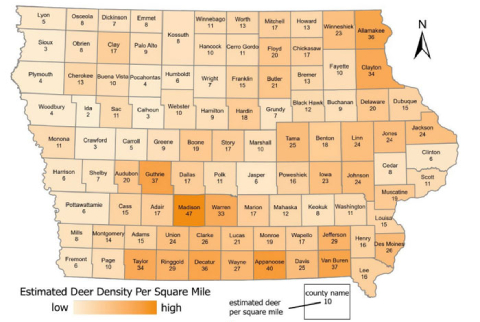By Dar Danielson (Radio Iowa)
A study requested by the Iowa Legislature from the Iowa Department of Natural Resources estimates the benefit of deer in the state far exceeds the damage done to crops and cars.
DNR State deer biologist Jace Elliott says all the numbers they have on deer were combined into one. “this is the first time that any sort of work like this has been done in Iowa. Previously, we have relied on multiple different data sets that again reflected trends but weren’t exactly estimating deer abundance,” Elliott says. The DNR worked with Iowa State University, the Iowa DOT, and Iowa Insurance Division to estimate the population of white-tailed deer and its economic impact.
Elliott says the population numbers confirmed the trends they’d suspected. “What we found from this study was that populations are the highest in eastern and southern Iowa. So for instance, south-central Iowa, northeastern Iowa, places that we see a lot of deer harvest, a lot of deer hunting effort and things like that,” he says. “So it didn’t exactly surprise us when we got those results.”
Elliott says they determined the economic impact of deer by using things such as hunting fees that they could track, but says it is hard to calculate all the impact. “The minimum tangible value of deer to Iowa is about 181 million dollars per year. The true value is likely much greater, especially when we are unable to account for intangible benefits, like people enjoying them on the landscape, wildlife viewing and other things like that,” Elliott says.
The negative costs from the deer herd was much lower. “When it comes to the cost of deer-vehicle collisions, that was estimated at $129 million per year, and crop damage in total, and this is accounting for row crops as well as specialty crops, was estimated at $8.6 million,” he says. It’s not easy to make a plus and minus impact from the deer population — because if you hit one with your car, you re not happy. But if you bag a ten-pointer while hunting, you are happy.
“When we go through, the sort of cost benefit exercise, it’s easy to make it look like these costs are pitted against the benefits. But in reality, most Iowans appreciate having deer on the landscape, but would prefer to be minimally burdened by them,” Elliott says. “And at the same time, there are over 160,000 deer hunters in the state that pursue that with their free time.”
He says the study shows the need to continue their practices in deer management. “What’s very clear is the importance of managing this species in a way that maximizes benefits and minimizes costs, and that’s going to perhaps mean different things to different people, but that’s why we focus on an engaged stakeholder process when we talk about managing this species in the state,” Elliott says.
The study says white-tailed deer were abundant when European settlers arrived in Iowa in the early 1800s but by 1880 were rarely seen and in the deer season was legally closed in 1898. They were re-establishment and the estimate of the population in 1936 placed statewide numbers between 500 and 700. The population increased and the deer harvest topped 100,000 for the first time in 1996.




